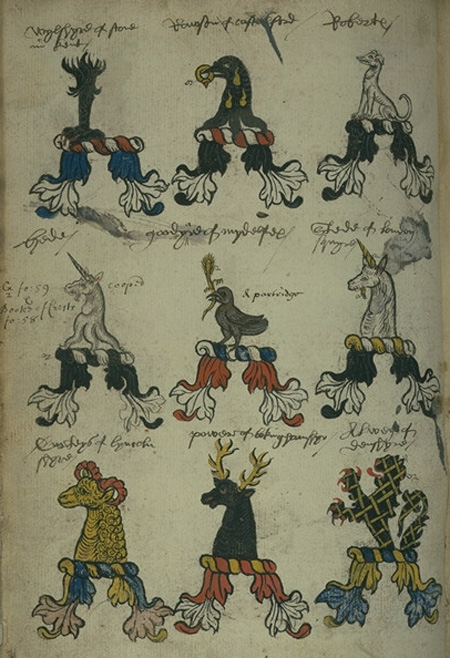| Frequently Asked Questions |
| Labelled illustration of a full achievement of arms |
| Q. Do coats of arms belong to surnames? |
| A. No. There is no such thing as a 'coat of arms for a surname'. Many people of the same surname will often be entitled to completely different coats of arms, and many of that surname will be entitled to no coat of arms. Coats of arms belong to individuals. For any person to have a right to a coat of arms they must either have had it granted to them or be descended in the legitimate male line from a person to whom arms were granted or confirmed in the past. |
| Q. What are the pantone numbers for the colours used in heraldry? |
| A. There are no fixed shades for heraldic colours. If the official description of a coat of arms gives its tinctures as Gules (red), Azure (blue) and Argent (white or silver) then, as long as the blue is not too light and the red not too orange, purple or pink, it is up to the artist to decide which particular shades they think are appropriate. |
| Q. What is a crest? |
A. It is a popular misconception that the word 'crest' describes a whole coat of arms or any heraldic device. It does not. A crest is a specific part of a full achievement of arms: the three-dimensional object placed on top of the helm. |
 Crests shown without their accompanying shields, in a Tudor manuscript |
| See the labelled illustration of a full achievement of arms here. |
| Q. Can the College of Arms tell me what my clan badge is? |
| A. No. The first point to note is that the apparently quite widespread, but new, belief that everyone has a clan, and can wear some specific tartan or display a clan badge, is quite erroneous. Only those of Scottish descent can be associated with a clan in any way. The clan system is an entirely Scottish phenomenon, and consists of a few groups of families, centred on old and historically prominent families, with other associated families (some of the same name as the principal lineage, but many not). To count as a clan, with a chief, these groups need to be recognized as such by the chief Scottish herald, the Lord Lyon King of Arms. This leads on to the second point, which is that it is Lord Lyon, and not the English College of Arms, who has authority and responsibility over matters relating to clans. |
